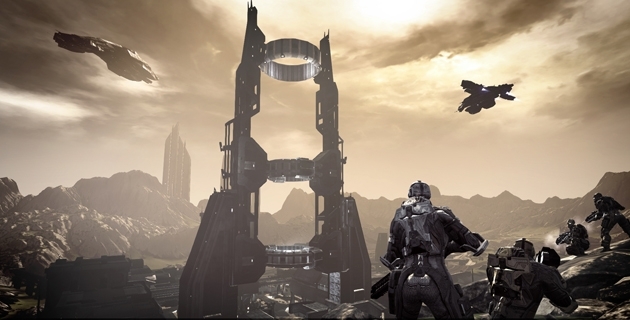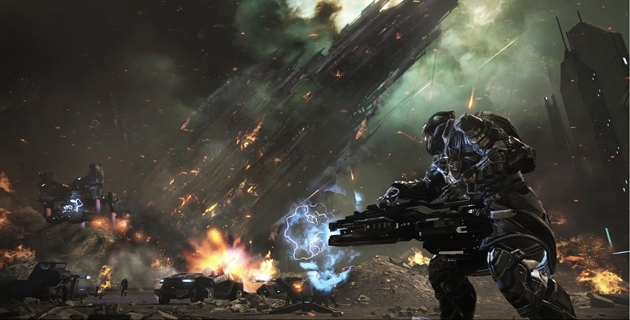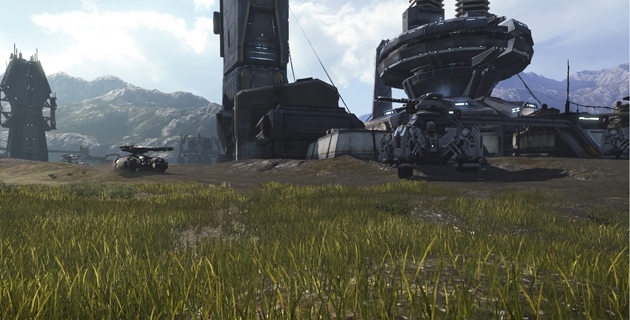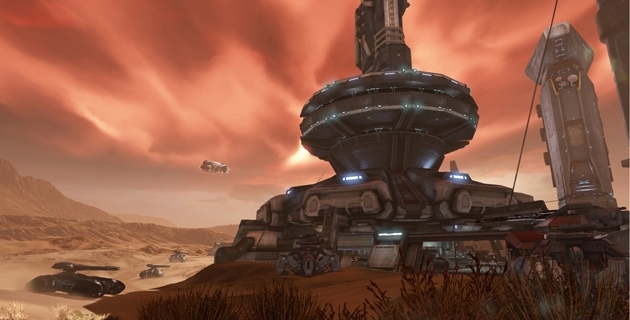DUST 514: The Launch of a Better Deal
Launching today, DUST 514 promises a better deal for console gamers. But can it deliver? We interview executive producer Brandon Laurino and game designer Eino Joas to find out.

Today, CCP pulls the shrink-wrap off its latest game. After running in open beta since January 22, DUST 514 is ready for prime time. Developed in Shanghai exclusively for the PlayStation 3, the MMOFPS represents a new window on EVE Online’s universe of New Eden.
More importantly, the Icelandic developer sees DUST 514 as the start of a new deal for console-bound FPS gamers. As Chief Marketing Officer David Reid put it, there are tens of millions of Battlefield and Call of Duty players waiting to be liberated from a prison that they don’t know they’re in.
Those are powerful words, but what does CCP actually mean by them? I sat down with DUST 514’s executive producer Brandon Laurino and asked him that very question. For him, it’s all about having a better social contract with the gamer – providing regular updates to a free-to-play game instead of charging the full retail price for a new version each year.
“EVE Online is definitely one of the great examples of being a great game as a service. All these free updates for its subscribers over these ten years - major graphics overhauls, all this kind of stuff. Never a sequel. With a graphics overhaul we could have had EVE Online 2, and sold that at sixty bucks to the consumer. We don’t do that, we have this service and we just keep updating and upgrading it, and it’s the same thing with DUST. It’s a game as a service - we will never make a ‘DUST 2’, the service just continues and we continue to improve, and update, and iterate on that.”
“Another thing that we do very uniquely is that we arguably do it in closer collaboration with our user base and our community, more so than any developer. FanFest is a very extreme manifestation of that, and if you look at our round tables and sessions it’s not just a basic Q and A, it’s real feedback that we really act on. All the way up to having our own player elected council that we fly to Iceland. Now we have the dust version of that council that we are flying to Shanghai, and they come and they actually participate in development. They sit with us, we get their feedback, we talk about features with them, we talk about the long view with them, about what we’re doing, and really collaborate with them on where we’re going.”
“By the same token we are an independent developer. We’re the world’s largest independent online games developer, and we have to do things on a different scale from some of the players that we’re competing with, and so we really rely on this evolved social contract to sustain our business.”

Non-stop Corporations
That community has been the lifeblood of DUST 514. By operating as an extension of EVE Online, CCP has been able to tap into a ready-made collection of corporations and alliances, all eager to hire mercenaries for the latest phase in galactic domination. While you can treat DUST 514 as a team-based shooter without any further thought, the game becomes much deeper when you group up with others.
Although both EVE Online and Dust 514 have been sharing the single Tranquillity server since January, large-scale interaction between the two games has been slower in emerging. That changed with the Battle for Caldari Prime, an event at PAX East that bridged both games. It was a tracer bullet for what was to come – full blown planetary conquest.
“We’ve introduced a whole new star map, which is the same as it is in EVE, but it’s visualised in 2D to make it easier to navigate on console. And you can designate planets and districts on planets that you want to attack. You can own that property on the planets, you can obviously fight over it with people who are competing for that territory. And then, once you own it, you can build on top of it, and what you build gives you buffs in both EVE and DUST. So that is a major update to the connection between these two games.”
To truly go cross-game, you need both cross-game corporations and a way for them to communicate. According to Laurino, that’s already happened, with voice and text chat already running – for free – between both games. It’s even possible to make custom channels with a mix of EVE and DUST players.
“Corporations are alive and kicking. There’re all kinds of interesting skulduggery going on around it. There’s not an EVE corporation or a DUST corporation - you can be a DUST player and join an EVE corporation that’s been going on for almost ten years now. You can be a DUST player, start a corporation and recruit people into it. These are completely the same entity, and definitely most of the major corporations in game have already been playing between the two of them and building up their immortal soldier corps so to speak. But now with planetary conquest we’re really giving them a tool to wage that war they’ve been preparing for.”

Opening New Windows
When I initially thought about it, DUST 514 seemed like an outlandish idea. After spending a decade as a PC-only sandbox developer, why did CCP decide to switch gears and develop a console-based first-person shooter? Laurino explained: “The concept itself has been bubbling around CCP for almost as long as EVE Online’s been around. There were always thoughts of this grand vision of a true living universe where you can do whatever you want. DUST is another step toward that vision.”
“If you think of Star Wars as we all like to do, if you look at Luke Skywalker, he has the choice of doing all of these things. He was a farm boy. Then he’s a knight, and he’s wielding this sabre, and he’s learning how to sword fight. But then he’s a pilot, and he has this piloting experience. He has all these different experiences and he’s not limited, just as you’re not limited in the real world. If you want to go be a mathematician you can study, train and work toward being a mathematician. If you want to be a cook, study and train to be a cook.
“Part of the vision for the EVE universe is to create a real living sci-fi universe and, arguably, evolve the interactive entertainment medium. We’ve gone much further than just about anyone else in terms of the sheer openness and variety of things you can do within our sandbox. We don’t script a lot of things, we don’t script a lot of events, and we try to make all of these tools for people to make their own lives in our universe. And so DUST is another dimension of that
“Where it gets interesting is in our productization strategy. Other online games, they try to cram all of these experiences into one client. It just becomes this sort of mishmash of a lot of things that are sort of half-baked. You have your WoW-style MMO and then they go ‘ok, now we need this dogfighting element’, and you get this sort of half-assed flying game crammed in. Whereas our strategy is to create distinct, focused products around these experiences. Could we have crammed some lame shooter into the EVE client? Yes, probably. But instead we created a whole studio and a whole development effort and a whole product around the shooter experience. And that’s really a key differentiator in terms of our product strategy and our approach to having a franchise.”

Merging Economies
A strong part of EVE Online is the economy – almost everything is built, bought and destroyed by the players. Fortunes can be made and lost by making the right – or wrong – choices. The Battle of Asakai was a perfect demonstration – one error resulted in billions of InterStellar Kredits (ISK) worth of damage. Because it’s possible to indirectly buy ISK for real money through trading Pilot Licence Extensions (PLEX), that damage can have a dollar value in the tens of thousands.
Bringing those two economies together – one incredibly mature, the other just starting out – is a delicate task. It’s a job made all the more poignant considering Iceland’s own financial history as a small economy as part of the much wider European Union. As I listened to a keynote delivered by CCP’s lead economist Dr Eyjólfur Guðmundsson, he was keen to stress that they were keen to learn from Iceland’s own recession and, while they might be linked, that the DUST economy has to be able to function independently of EVE Online.
In order to understand how the two economies would mesh together, I spoke with game designer Eino Joas, the person responsible for managing and developing DUST’s fledgling economy. Laboring alongside Dr Guðmundsson, the pair works with a team of researchers and analysts in tracking and understanding the two markets. According to Joas, most of their time is spent researching rather than acting.
“On the Dust side, most of the time it’s mostly observing and deliberating on what would be the right course of action, because, when you make the changes, you want to be well informed of what you’re doing. I would say most of our time is actually just spent looking at data and digging into what is happening, why it’s happening, what might be the causes, what might be contributing and trying to find out what the real mechanics are. And then, once you find the mechanics, you basically just design a response and implement. Then you just observe again, see what happens, see if your thoughts were correct. You should see pretty easily from the data if you’re wrong or right after you’ve made the changes.”



